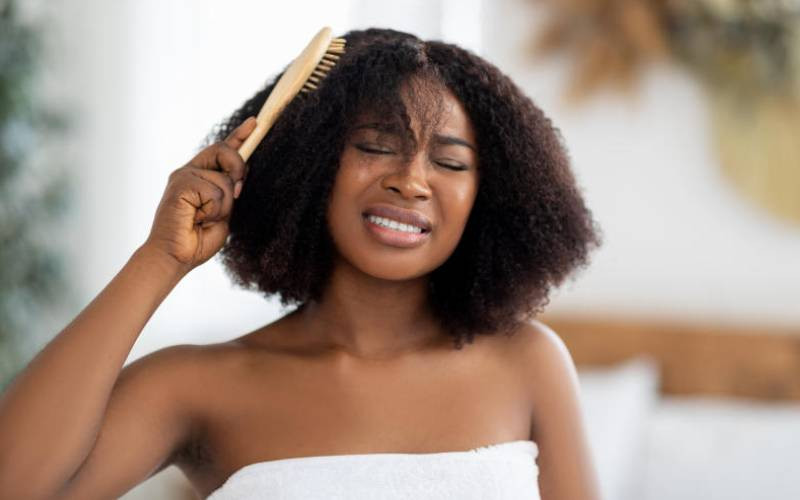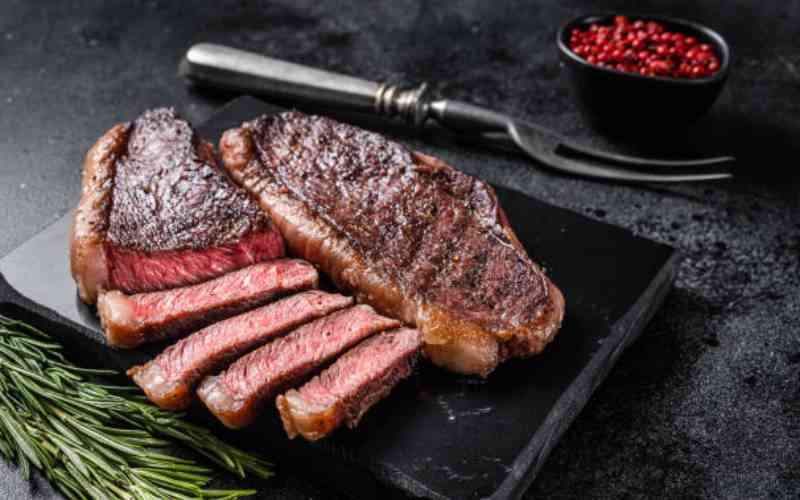
Typical African hair is curly and kinky, which is beautiful. However, even natural sisters want to rock straight hairstyles once in a while.
Straightening African hair has, however, become a touchy subject as more black women adopt the natural hair movement. The aversion to hair straightening is understandable, bearing in mind that most straightening methods can be damaging to your hair’s natural curl pattern and glow.
Kinky hair is structured differently from types of hair with looser curls. Type 4C hair tends to have flatter ore elliptical follicles, leading to more bends and curls along the hair strand.
At each curl or bend, the strand has a point of weakness. This explains why kinky hair is more fragile than hair types with looser curls. When you straighten the hair, forcing it to go against its natural curl, it can lead to weakening and breakage.
Applying heat on your hair strands also vapourises water molecules, which alters your hair’s natural curl patterns. While this leads to straighter hair, it can also cause frizz and generally dry and brittle hair.
High temperatures also lead to the formation of cracks and ruptures as it breaks down keratin in your hair strand, making it vulnerable to breakage.
The good news is that it is possible to straighten your hair without damaging it. Straightening your natural hair can give you that occasional style change you crave. It comes in handy for measuring your actual length after months or years of protective styling.
With that in mind, here are powerful tips to remember to straighten your kinky hair without causing too much damage:

Avoid Heat for Straightening
Heat is popular for straightening kinky hair. After all, it is cheap, fast, and effective. If you do not want to interfere with your hair’s natural curl pattern, it is best to avoid heat. You can opt for other methods such as using rollers of threading.
Without heat or chemicals, your hair is unlikely to turn out bone straight. However, you will have a natural blown-out look without the risk of damage. You can wear your hair down or pull it into an elaborate up do and other styles.
If you decide to go for no-heat straightening methods, remember to first detangle your curls using your fingers. Take small clumps of hair and wrap them around a thread, nylon stockings, or rollers.
This method is most effective when you start with wet hair. Only unravel the thread or roller once your hair is completely dry.
Other heat-free hair straightening methods include gelling and banding. You can simply apply gel and style your hair into elegant up-dos, which will look great for weddings and other formal functions. All you need to do is add a puff or long extension to look effortlessly chic.
Use a Heat Protectant
If you opt to use heat for hair straightening anyway, you can still guard your curls by using a silicone-based heat protectant. Such heat protectants form a coating around each individual strand, protecting your precious curls from the damaging effects associated with heat straightening.
Heat protectants add a barrier between the heat-styling tool and your hair, sealing in precious moisture while keeping out the frizz. Heat protectants also smoothen the hair cuticle, making your hair look and feel softer.
However, do not make a habit of using silicone-based hair products. While the ingredient is great for occasional use, it can make your hair weak and brittle when used regularly.

Use Low Heat
When you are heat-straightening your hair, you might be tempted to crank up the heat to maximum. Do not fall for the temptation – it will only increase your hair damage.
Do not sacrifice your hard-earned healthy natural hair for short-term rewards. Yes, your hair might end up looking straighter for the week, but it will have more damage. In fact, you may be unable to go back to your natural curl pattern even after washing your hair.
Experts recommend keeping your heat no higher than 450F. Adjust your flat iron to around 350F to keep your hair’s heat damage at a minimum.
Focus on Aftercare
Preventing damage does not end with deciding which straightening methods to use. Most of your hair damage is likely to occur after the straightening itself – hence it makes sense to focus on aftercare.
After blow-drying your hair or flat-ironing it, it may look great for a week. After that, it may start looking dry and brittle.
Proper aftercare should always involve deep conditioning and protein masks. The two treatments will put moisture back into your hair strands and patch up any holes that were left by straightening. This will not only make your hair look shinier, it will also strengthen your hair and prevent breakage.
Plan to do both deep conditioning and protein masks the week before and the week after your straightening. If you focus on careful aftercare, you can get away with straightening your hair every now and then.
To maintain your straightened hair, make sure to wrap it up with a silk or satin scarf before bed. It also makes sense to invest in silk or satin pillowcases that won’t absorb oils and moisture from your hair while you are getting your precious beauty sleep.
 The Standard Group Plc is a multi-media organization with investments in media platforms spanning newspaper print
operations, television, radio broadcasting, digital and online services. The Standard Group is recognized as a
leading multi-media house in Kenya with a key influence in matters of national and international interest.
The Standard Group Plc is a multi-media organization with investments in media platforms spanning newspaper print
operations, television, radio broadcasting, digital and online services. The Standard Group is recognized as a
leading multi-media house in Kenya with a key influence in matters of national and international interest.


